
The Alliance for Zero Extinction (AZE) is a network of 88 prominent conservation groups from 35 countries that is calling for support from the global community to protect “AZE sites”, which are locations identified by conservation scientists where Endangered or Critically Endangered species are known from only one place on Earth.
The AZE 7 Wonders campaign received more than 100,000 votes from the public via social media (click to visit AZE’s Facebook page). To choose the seven winners, votes were cast for 20 short-listed sites selected from among the 587 AZE sites so far identified globally.
“Each of these phenomenal sites holds a unique wonder of nature – be it a charismatic bird, frog, turtle, or mammal – that is worth protecting in perpetuity. While today we are announcing 7 Wonders, AZE sites are really 587 wonders around the world,” said American Bird Conservancy’s Mike Parr who serves as Chairman of AZE. “The good news is that some of these sites and species already receive protection through public or private protected areas, but we still need to expand these programs to more places.”
“Many organizations and governments are succeeding in conserving these last unique refuges for the world’s most endangered wildlife. This is really a story of survival, not one of extinction, but we must recognize that many of these species do still need an extra helping hand if they are to survive into the future. This is the United Nations Decade on Biodiversity, and a perfect time for us to make a global push to protect the remaining sites in need. Nations are coming together to save the world’s species and wild places through the Convention on Biological Diversity, so there is huge cause for optimism,” Parr added.
“The 7 Wonders campaign not only raises the profile of these critically endangered species, above all else, it reminds people of the places that need to be protected if we are to stop extinctions. World governments agreed to take effective and urgent action to halt the loss of biodiversity and ending extinctions is critical to achieving that. This campaign is yet another excellent contribution of the Alliance for Zero Extinction to the achievement of the Aichi (Japan) Targets and the Strategic Plan for Biodiversity.” Said Braulio Ferreira de Souza Dias, Executive Secretary of the Convention on Biological Diversity.
“Protecting all of Earth’s AZE sites is a realistic goal and one that could be accomplished in just a few years if the global biodiversity conservation community works together,” said Gustavo Fonseca, Head of Natural Resources at the Global Environment Facility. “It is a critical and measurable first step toward halting human-caused extinctions.”
“AZE sites are without a doubt ‘the tip of the iceberg’ in efforts to maintain global biodiversity, and deserve urgent and very special attention. I have visited many of those sites and personally observed the remarkable endemic species that live in these precious habitats. Saving these sites and the species they support is, without doubt, one of the important mandates we all face as conservationists,” said Dr. Russell Mittermeier, President of Conservation International and AZE Steering Committee member.
The AZE 7 Wonders campaign was launched in September 2012, at the World Conservation Congress in Jeju, South Korea, where some 8,000 people gathered to address global conservation issues. The congress was hosted by the International Union for the Conservation of Nature (IUCN). The IUCN Red List of Threatened Species was used by AZE to help identify 920 Endangered and Critically Endangered species restricted to the 587 AZE sites worldwide (click here to see the complete global AZE site map).
The AZE 7 Wonders Sites and their AZE Species are:
Rodrigues Mainland, Mauritius – Rodrigues Flying Fox
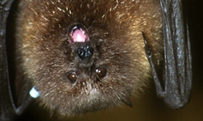
The Rodrigues flying fox is most active at dawn and dusk when it leaves its cave or tree to search for its food which consists primarily of fruit. Like most fruit bats, it does not possess the ability to echolocate, but relies on its sense of smell and large eyes that provide good vision in low light. It faces threats from habitat loss and hunting. Efforts are underway to breed the species in captivity. The Rodrigues Warbler also calls this site its only home. AZE member Bat Conservation International, along with Mauritius Wildlife Foundation, works to conserve bat populations around the world.
“The Rodrigues flying fox is beautifully adapted to the dry woodlands of its small Indian Ocean island. Unfortunately, it’s not alone in its troubles – island bats around the world face similar, severe threats. AZE’s 7 Wonders is an important reminder of all that we lose when species go extinct.” said Andrew Walker, Executive Director, Bat Conservation International.
Abra Patricia, Peru – Long-whiskered Owlet
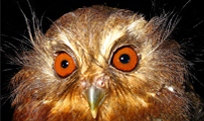 The Long-whiskered Owlet feeds primarily on insects, and is one of the smallest owl species in the world. The owlet faces habitat loss due to timber extraction and agricultural expansion. The Ochre-fronted Antpitta also calls this site its only home. Private and community protected areas have been established by AZE members ECOAN and American Bird Conservancy to safeguard habitat for these species.
The Long-whiskered Owlet feeds primarily on insects, and is one of the smallest owl species in the world. The owlet faces habitat loss due to timber extraction and agricultural expansion. The Ochre-fronted Antpitta also calls this site its only home. Private and community protected areas have been established by AZE members ECOAN and American Bird Conservancy to safeguard habitat for these species.
Río Saija, Colombia – Golden Poison Frog
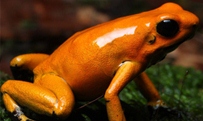 The golden poison frog is one of the most toxic animals in the world; a two inch specimen has enough poison to kill ten people. The frog’s bright coloring, which varies from yellow to orange to pale green, serves as a warning to potential predators. Threats to the frog include deforestation for agriculture, and potentially a fungal-borne disease. This is one of two endangered species found only here. A new reserve established by AZE member Fundación ProAves with help from Conservation International, World Land Trust, and Global Wildlife Conservation now protects a small population, but more help is needed.
The golden poison frog is one of the most toxic animals in the world; a two inch specimen has enough poison to kill ten people. The frog’s bright coloring, which varies from yellow to orange to pale green, serves as a warning to potential predators. Threats to the frog include deforestation for agriculture, and potentially a fungal-borne disease. This is one of two endangered species found only here. A new reserve established by AZE member Fundación ProAves with help from Conservation International, World Land Trust, and Global Wildlife Conservation now protects a small population, but more help is needed.
Roti Island, Indonesia – Roti Island Snake-necked Turtle
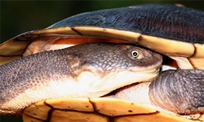 The Roti Island snake-necked turtle is one of the most endangered turtles in the world. It has been severely diminished by the illegal pet trade. Efforts are underway to breed this species in captivity and to hopefully initiate a reintroduction program. The Turtle Conservation Fund, Turtle Survival Alliance, and Chelonian Research Foundation are AZE members, and with the IUCN Tortoise and Freshwater Turtle Specialist Group, are leading champions of turtle conservation efforts worldwide.
The Roti Island snake-necked turtle is one of the most endangered turtles in the world. It has been severely diminished by the illegal pet trade. Efforts are underway to breed this species in captivity and to hopefully initiate a reintroduction program. The Turtle Conservation Fund, Turtle Survival Alliance, and Chelonian Research Foundation are AZE members, and with the IUCN Tortoise and Freshwater Turtle Specialist Group, are leading champions of turtle conservation efforts worldwide.
Poyang Hu, China – Siberian Crane
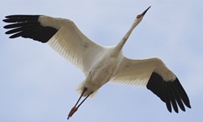
It’s hard to “hide” 3,000 tall, white Siberian Cranes, but that’s what Poyang Lake did for many years until the wintering density of these spectacular birds there became widely known to ornithologists. The lake’s dramatic water fluctuations are key to the wetlands’ productivity, and provide habitat for more than 400,000 total waterbirds in winter. China’s finless porpoise is highly threatened and also found here. Impacts of dams in the catchment, sand dredging, and climate change threaten the lake. AZE member, the International Crane Foundation (ICF) is a leading champion of crane conservation efforts worldwide.
“AZE’s Seven Wonders Campaign is dramatically expressing global interest in conservation of this unique wetland, at a time when its future is very much in doubt,” said Jim Harris, Senior Vice President of ICF. “The positive nature of this campaign makes it especially useful as a support for conservation in China.”
Raso da Catarina, Brazil – Lear’s Macaw
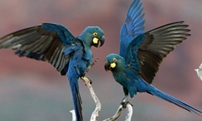 The Lear’s Macaw was down-listed from Critically Endangered to Endangered in 2009 thanks to intensive conservation action, though it still faces threats from the illegal global pet trade and habitat destruction for livestock grazing. A private reserve established by AZE member Fundação Biodiversitas with support from American Bird Conservancy includes a research station and guest lodge at this site.
The Lear’s Macaw was down-listed from Critically Endangered to Endangered in 2009 thanks to intensive conservation action, though it still faces threats from the illegal global pet trade and habitat destruction for livestock grazing. A private reserve established by AZE member Fundação Biodiversitas with support from American Bird Conservancy includes a research station and guest lodge at this site.
Isla Robinson Crusoe, Chile – Juan Fernández Firecrown
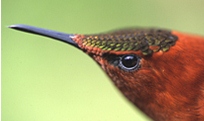
This 36-square-mile island off the Pacific coast of Chile is home to the Juan Fernández Firecrown’s only remaining population. This spectacular hummingbird continues to be threatened by habitat degradation from invasive plants and predation by domestic cats, although conservation measures are underway to address these issues. The island has a literary heritage as well, serving as inspiration for Daniel Defoe’s Robinson Crusoe, Jonathan Franzen’s account in the New Yorker, and Eric Dinerstein’s new book The Kingdom of Rarities. The non-profit organization Juan Fernández Islands Conservancy/Oikonos is leading conservation efforts on the island.
“The designation of Isla Robinson Crusoe as one of the AZE 7 Wonders of the World is an important recognition of the global significance of the island, not just for the Juan Fernández Firecrown but also for other endangered endemic species and the unique ecosystems on which they depend. We hope that this innovative campaign will generate additional support for the critical conservation work necessary for the island.” Said Peter Hodum, Board Member of Oikonos.
The winning sites are also featured on the Alliance for Zero Extinction website.
ABC is a founding member of the Alliance for Zero Extinction, a joint initiative that aims to prevent species extinctions by identifying and safeguarding key sites, each of which is the last remaining refuge for one or more Endangered or Critically Endangered species. AZE’s goal is to create a frontline of defense against extinction by protecting as many of these sites as possible. AZE focuses on known extinction crises and expands its focus as new information emerges on species and habitat status.
